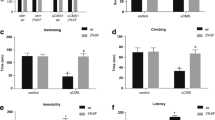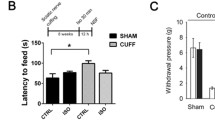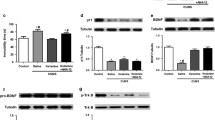Abstract
Rationale
The volatile anesthetic isoflurane is suggested to produce a rapid and robust antidepressive effect in preliminary clinical trials. Recently, isoflurane was found to activate the tropomyosin receptor kinase B (TrkB) signaling which is the underlying mechanism of the rapid antidepressant ketamine.
Objective
Our study investigated the effect of isoflurane anesthesia on chronic unpredictable mild stressed (CUMS) model in mice and verified the role of brain-derived neurotrophic factor (BDNF)/TrkB/ the mammalian target of rapamycin (mTOR) signaling in the antidepressant effect of isoflurane.
Methods
We employed the CUMS model of depression to assess the rapid antidepressant effect of isoflurane by the forced swimming test (FST), the sucrose preference test (SPT), and the novelty suppressed feeding test (NSFT). The protein expression of BDNF and TrkB/protein kinase B (PKB or Akt)/mTOR was determined through Western blot. The dendritic spine density in the hippocampus and medial prefrontal cortex (PFC) was measured by the Golgi staining.
Results
A brief burst-suppressing isoflurane anesthesia rapidly reversed the behavioral deficits caused by CUMS procedure, normalized the expression of BDNF and further activated the TrkB signaling pathway in CUMS-induced stressed mice in both prefrontal cortex (PFC) and hippocampus (HC). All of those behavioral and proteomic effects were blocked by K252a, a selective receptor inhibitor of TrkB. Isoflurane significantly promoted the formation of dendritic spines in both medial prefrontal cortex (mPFC), CA1, CA3, and DG of the hippocampus.
Conclusion
Our study indicates that isoflurane exerts a rapid antidepressant-like effect in CUMS depression animal model, and the activation of BDNF/TrkB signaling pathway plays an indispensable role in the biological and behavioral antidepressant effects of isoflurane. A single exposure to isoflurane could repair synaptic damage caused by chronic stimulation.





Similar content being viewed by others
References
Abdallah CG, Sanacora G, Duman RS, Krystal JH (2018) The neurobiology of depression, ketamine and rapid-acting antidepressants: is it glutamate inhibition or activation? Pharmacol Ther 190:148–158
Abelaira HM, Réus GZ, Neotti MV, Quevedo J (2014) The role of mTOR in depression and antidepressant responses. Life Sci 101(1–2):10–14
Abrams R (2002) Electroconvulsive therapy (ECT) practice in metropolitan New York community hospitals. Psychol Med 32(7):1323–1324 author reply 24-6
Adell A, Castro E, Celada P, Bortolozzi A, Pazos A, Artigas F (2005) Strategies for producing faster acting antidepressants. Drug Discov Today 10(8):578–585
Antila H, Ryazantseva M, Popova D, Sipilä P, Guirado R, Kohtala S, Yalcin I, Lindholm J, Vesa L, Sato V, Cordeira J, Autio H, Kislin M, Rios M, Joca S, Casarotto P, Khiroug L, Lauri S, Taira T, Castrén E, Rantamäki T (2017) Isoflurane produces antidepressant effects and induces TrkB signaling in rodents. Sci Rep 7(1):7811
Autry AE, Adachi M, Nosyreva E, Na ES, Los MF, Cheng PF, Kavalali ET, Monteggia LM (2011) NMDA receptor blockade at rest triggers rapid behavioural antidepressant responses. Nature 475(7354):91–95
Berman RM, Cappiello A, Anand A, Oren DA, Heninger GR, Charney DS, Krystal JH (2000) Antidepressant effects of ketamine in depressed patients. Biol Psychiatry 47(4):351–354
Brown PL, Zanos P, Wang L, Elmer GI, Gould TD, Shepard PD (2018) Isoflurane but not halothane prevents and reverses helpless behavior: a role for EEG burst suppression? Int J Neuropsychopharmacol 21:777–785
Cai Y, Peng Z, Guo H, Wang F, Zeng Y (2017) TREK-1 pathway mediates isoflurane-induced memory impairment in middle-aged mice. Neurobiol Learn Mem 145:199–204
Carl C, Engelhardt W, Teichmann G, Fuchs G (1988) Open comparative study with treatment-refractory depressed patients: electroconvulsive therapy--anesthetic therapy with isoflurane (preliminary report). Pharmacopsychiatry 21(6):432–433
Castren E, Voikar V, Rantamaki T (2007) Role of neurotrophic factors in depression. Curr Opin Pharmacol 7(1):18–21
Chandran A, Iyo AH, Jernigan CS, Legutko B, Austin MC, Karolewicz B (2013) Reduced phosphorylation of the mTOR signaling pathway components in the amygdala of rats exposed to chronic stress. Prog Neuro-Psychopharmacol Biol Psychiatry 40:240–245
Cryan JF, Mombereau C (2004) In search of a depressed mouse: utility of models for studying depression-related behavior in genetically modified mice. Mol Psychiatry 9:326–357
Der-Avakian A, Markou A (2012) The neurobiology of anhedonia and other reward-related deficits. Trends Neurosci 35(1):68–77
Di Lieto A et al (2012) The responsiveness of TrkB to BDNF and antidepressant drugs is differentially regulated during mouse development. PLoS One 7(3):e32869
Dincheva I, Lynch NB, Lee FS (2016) The role of BDNF in the development of fear learning. Depress Anxiety 33(10):907–916
Dincheva I, Yang J, Li A, Marinic T, Freilingsdorf H, Huang C, Casey BJ, Hempstead B, Glatt CE, Lee FS, Bath KG, Jing D (2017) Effect of early-life fluoxetine on anxiety-like behaviors in BDNF Val66Met mice. Am J Psychiatry 174(12):1203–1213
Drevets WC (1998) Functional neuroimaging studies of depression: the anatomy of melancholia. Annu Rev Med 49:341–361
Engelhardt W, Carl G, Hartung E (1993) Intra-individual open comparison of burst-suppression-isoflurane-anaesthesia versus electroconvulsive therapy in the treatment of severe depression. Eur J Anaesthesiol 10(2):113–118
Garcia LS et al (2009) Ketamine treatment reverses behavioral and physiological alterations induced by chronic mild stress in rats. Prog Neuro-Psychopharmacol Biol Psychiatry 33(3):450–455
Greenberg LB et al (1987) Isoflurane anesthesia therapy: a replacement for ECT in depressive disorders? Convuls Ther 3(4):269–277
Heurteaux C, Lucas G, Guy N, el Yacoubi M, Thümmler S, Peng XD, Noble F, Blondeau N, Widmann C, Borsotto M, Gobbi G, Vaugeois JM, Debonnel G, Lazdunski M (2006) Deletion of the background potassium channel TREK-1 results in a depression-resistant phenotype. Nat Neurosci 9(9):1134–1141
Hoeffer CA, Klann E (2010) mTOR signaling: at the crossroads of plasticity, memory and disease. Trends Neurosci 33(2):67–75
Ignacio ZM et al (2016) New perspectives on the involvement of mTOR in depression as well as in the action of antidepressant drugs. Br J Clin Pharmacol 82(5):1280–1290
Kasmi Y (2002) Electroconvulsive therapy and cognitive function. Ir J Psychol Med 19(2):70–71
Kato T, et al. (2017) ‘BDNF release and signaling are required for the antidepressant actions of GLYX-13’, Mol Psychiatry
Kohtala S, Theilmann W, Suomi T, Wigren HK, Porkka-Heiskanen T, Elo LL, Rokka A, Rantamäki T (2016) Brief isoflurane anesthesia produces prominent Phosphoproteomic changes in the adult mouse Hippocampus. ACS Chem Neurosci 7(6):749–756
Koinig G, Langer G (1988) Might “isoflurane Narcotherapy” replace ECT? Convuls Ther 4(1):98–99
Langer G, Neumark J, Koinig G, Graf M, Schönbeck G (1985) Rapid psychotherapeutic effects of anesthesia with isoflurane (ES narcotherapy) in treatment-refractory depressed patients. Neuropsychobiology 14(3):118–120
Langer G, Karazman R, Neumark J, Saletu B, Schönbeck G, Grünberger J, Dittrich R, Petricek W, Hoffmann P, Linzmayer L, Anderer P, Steinberger K (1995) Isoflurane narcotherapy in depressive patients refractory to conventional antidepressant drug treatment. A double-blind comparison with electroconvulsive treatment. Neuropsychobiology 31(4):182–194
Lepack AE, Fuchikami M, Dwyer JM, Banasr M, Duman RS (2015) BDNF release is required for the behavioral actions of ketamine. Int J Neuropsychopharmacol 18(1):pyu033
Li N, Lee B, Liu RJ, Banasr M, Dwyer JM, Iwata M, Li XY, Aghajanian G, Duman RS (2010) mTOR-dependent synapse formation underlies the rapid antidepressant effects of NMDA antagonists. Science 329(5994):959–964
Li N, He X, Zhang Y, Qi X, Li H, Zhu X, He S (2011a) Brain-derived neurotrophic factor signalling mediates antidepressant effects of lamotrigine. Int J Neuropsychopharmacol 14(8):1091–1098
Li N, Liu RJ, Dwyer JM, Banasr M, Lee B, Son H, Li XY, Aghajanian G, Duman RS (2011b) Glutamate N-methyl-D-aspartate receptor antagonists rapidly reverse behavioral and synaptic deficits caused by chronic stress exposure. Biol Psychiatry 69(8):754–761
Lisanby SH (2007) Electroconvulsive therapy for depression. N Engl J Med 357(19):1939–1945
Liston C, Miller MM, Goldwater DS, Radley JJ, Rocher AB, Hof PR, Morrison JH, McEwen BS (2006) Stress-induced alterations in prefrontal cortical dendritic morphology predict selective impairments in perceptual attentional set-shifting. J Neurosci 26(30):7870–7874
Liu RJ, Aghajanian GK (2008) Stress blunts serotonin- and hypocretin-evoked EPSCs in prefrontal cortex: role of corticosterone-mediated apical dendritic atrophy. Proc Natl Acad Sci U S A 105(1):359–364
Louhivuori V, Vicario A, Uutela M, Rantamäki T, Louhivuori LM, Castrén E, Tongiorgi E, Åkerman KE, Castrén ML (2011) BDNF and TrkB in neuronal differentiation of Fmr1-knockout mouse. Neurobiol Dis 41(2):469–480
Malenka RC, Nestler EJ, Hyman SE (2009) Chapter 8: atypical neurotransmitters. In: Brown RY, Sydor A (eds) Molecular neuropharmacology: a Foundation for clinical neuroscience (2nd ed.). McGraw-Hill Medical, New York
Matsumoto T, Rauskolb S, Polack M, Klose J, Kolbeck R, Korte M, Barde YA (2008) Biosynthesis and processing of endogenous BDNF: CNS neurons store and secrete BDNF, not pro-BDNF. Nat Neurosci 11(2):131–133
Merikangas KR, Jin R, He JP, Kessler RC, Lee S, Sampson NA, Viana MC, Andrade LH, Hu C, Karam EG, Ladea M, Medina-Mora ME, Ono Y, Posada-Villa J, Sagar R, Wells JE, Zarkov Z (2011) Prevalence and correlates of bipolar spectrum disorder in the world mental health survey initiative. Arch Gen Psychiatry 68(3):241–251
Molendijk ML, van Tol MJ, Penninx BWJH, van der Wee NJA, Aleman A, Veltman DJ, Spinhoven P, Elzinga BM (2012) BDNF val66met affects hippocampal volume and emotion-related hippocampal memory activity. Transl Psychiatry 2:e74
Morris AJ, Roche SA, Bentham P, Wright J (2002) A dental risk management protocol for electroconvulsive therapy. J ECT 18(2):84–89
Mu RH, Fang XY, Wang SS, Li CF, Chen SM, Chen XM, Liu Q, Li YC, Yi LT (2016) Antidepressant-like effects of standardized gypenosides: involvement of brain-derived neurotrophic factor signaling in hippocampus. Psychopharmacology 233(17):3211–3221
Numakawa T, Adachi N, Richards M, Chiba S, Kunugi H (2013) Brain-derived neurotrophic factor and glucocorticoids: reciprocal influence on the central nervous system. Neuroscience 239:157–172
Nutt DJ, Ballenger JC, Sheehan D, Wittchen HU (2002) Generalized anxiety disorder: comorbidity, comparative biology and treatment. Int J Neuropsychopharmacol 5(4):315–325
Pezawas L, Verchinski BA, Mattay VS, Callicott JH, Kolachana BS, Straub RE, Egan MF, Meyer-Lindenberg A, Weinberger DR (2004) The brain-derived neurotrophic factor val66met polymorphism and variation in human cortical morphology. J Neurosci 24(45):10099–10102
Radley JJ, Morrison JH (2005) Repeated stress and structural plasticity in the brain. Ageing Res Rev 4(2):271–287
Rajkowska G, Miguel-Hidalgo JJ, Wei J, Dilley G, Pittman SD, Meltzer HY, Overholser JC, Roth BL, Stockmeier CA (1999) Morphometric evidence for neuronal and glial prefrontal cell pathology in major depression. Biol Psychiatry 45(9):1085–1098
Ramaker MJ, Dulawa SC (2017) Identifying fast-onset antidepressants using rodent models. Mol Psychiatry 22(5):656–665
Rantamaki T et al (2007) Pharmacologically diverse antidepressants rapidly activate brain-derived neurotrophic factor receptor TrkB and induce phospholipase-Cgamma signaling pathways in mouse brain. Neuropsychopharmacology 32(10):2152–2162
Rantamaki T et al (2011) Antidepressant drugs transactivate TrkB neurotrophin receptors in the adult rodent brain independently of BDNF and monoamine transporter blockade. PLoS One 6(6):e20567
Saarelainen T, Hendolin P, Lucas G, Koponen E, Sairanen M, MacDonald E, Agerman K, Haapasalo A, Nawa H, Aloyz R, Ernfors P, Castrén E (2003) Activation of the TrkB neurotrophin receptor is induced by antidepressant drugs and is required for antidepressant-induced behavioral effects. J Neurosci 23(1):349–357
Schmidt HD, Duman RS (2007) The role of neurotrophic factors in adult hippocampal neurogenesis, antidepressant treatments and animal models of depressive-like behavior. Behav Pharmacol 18(5–6):391–418
Si X-M et al. (2018) Low molecular mass chondroitin sulfate suppresses chronic unpredictable mild stress-induced depression-like behavior in mice (68) 361–71
Soares JC, Mann JJ (1997) The anatomy of mood disorders--review of structural neuroimaging studies. Biol Psychiatry 41(1):86–106
Strekalova T, Spanagel R, Bartsch D, Henn FA, Gass P (2004) Stress-induced anhedonia in mice is associated with deficits in forced swimming and exploration. Neuropsychopharmacology 29(11):2007–2017
Tadler SC, Mickey BJ (2018) Emerging evidence for antidepressant actions of anesthetic agents. Curr Opin Anaesthesiol 31(4):439–445
Tadler S, Light A, Hughen R (2009) Isoflurane demonstrates antidepressant-like activity in a mouse model of depression (Abstract). Anesth Analg 108:212
Tan X, du X, Jiang Y, Botchway BOA, Hu Z, Fang M (2018) Inhibition of autophagy in microglia alters depressive-like behavior via BDNF pathway in postpartum depression. Front Psychiatry 9:434
Theilmann W, Alitalo O, Yorke I, Rantamäki T (2019) Dose-dependent effects of isoflurane on TrkB and GSK3beta signaling: importance of burst suppression pattern. Neurosci Lett 694:29–33
Vutskits L (2012) General anesthesia: a gateway to modulate synapse formation and neural plasticity? Anesth Analg 115(5):1174–1182
Vutskits L (2018) General anesthetics to treat major depressive disorder: clinical relevance and underlying mechanisms. Anesth Analg 126(1):208–216
Warner-Schmidt JL, Duman RS (2007) VEGF is an essential mediator of the neurogenic and behavioral actions of antidepressants. Proc Natl Acad Sci U S A 104(11):4647–4652
Weeks HR III et al (2013) Antidepressant and neurocognitive effects of isoflurane anesthesia versus electroconvulsive therapy in refractory depression. PLoS One 8(7):e69809
WHO ‘Depression Fact Sheet’, [Internet], (updated 22 March 2018a) <http://www.who.int/news-room/fact-sheets/detail/depression>, Accessed 22 March
WHO ‘Suicide Fact Sheet’ [Internet]. <http://www.who.int/news-room/fact-sheets/detail/depression>, Accessed 24 Aug 2018b
Willner P (1997) Validity, reliability and utility of the chronic mild stress model of depression: a 10-year review and evaluation. Psychopharmacology 134(4):319–329
Willner P (2005) Chronic mild stress (CMS) revisited: consistency and behavioural-neurobiological concordance in the effects of CMS. Neuropsychobiology 52(2):90–110
Willner P (2017) The chronic mild stress (CMS) model of depression: history, evaluation and usage. Neurobiol Stress 6:78–93
Xu A, Cui S, Wang J-H (2015) Incoordination among Subcellular Compartments Is Associated with Depression-Like Behavior Induced by Chronic Mild Stress (19) pyv122
Yang J, Siao CJ, Nagappan G, Marinic T, Jing D, McGrath K, Chen ZY, Mark W, Tessarollo L, Lee FS, Lu B, Hempstead BL (2009) Neuronal release of proBDNF. Nat Neurosci 12(2):113–115
Ye D, Li Y, Zhang X, Guo F, Geng L, Zhang Q, Zhang Z (2015) TREK1 channel blockade induces an antidepressant-like response synergizing with 5-HT1A receptor signaling. Eur Neuropsychopharmacol 25(12):2426–2436
Zanos P, Moaddel R, Morris PJ, Georgiou P, Fischell J, Elmer GI, Alkondon M, Yuan P, Pribut HJ, Singh NS, Dossou KSS, Fang Y, Huang XP, Mayo CL, Wainer IW, Albuquerque EX, Thompson SM, Thomas CJ, Zarate Jr CA, Gould TD (2016) NMDAR inhibition-independent antidepressant actions of ketamine metabolites. Nature 533(7604):481–486
Funding
This work was supported by research grants from the National Natural Science Foundation of China (No. 31272397), the Natural Science Foundation of Shandong Province (No. ZR2011CM041), and the Qingdao Postdoctoral Application Research Project (2017).
Author information
Authors and Affiliations
Corresponding author
Ethics declarations
Conflict of interests
The authors declare that they have no conflict of interest.
Additional information
Publisher’s note
Springer Nature remains neutral with regard to jurisdictional claims in published maps and institutional affiliations.
Electronic supplementary material
ESM 1
(PDF 82 kb)
Rights and permissions
About this article
Cite this article
Zhang, SS., Tian, YH., Jin, SJ. et al. Isoflurane produces antidepressant effects inducing BDNF-TrkB signaling in CUMS mice. Psychopharmacology 236, 3301–3315 (2019). https://doi.org/10.1007/s00213-019-05287-z
Received:
Accepted:
Published:
Issue Date:
DOI: https://doi.org/10.1007/s00213-019-05287-z




